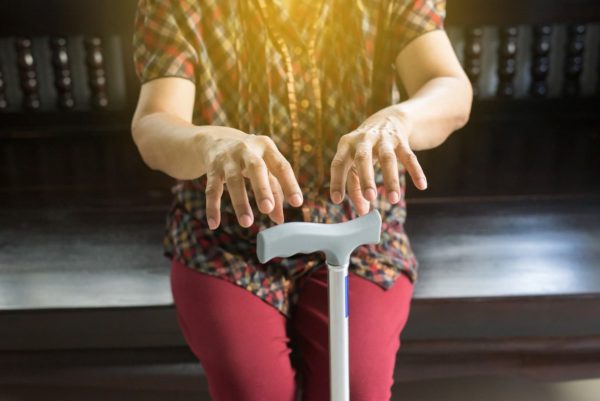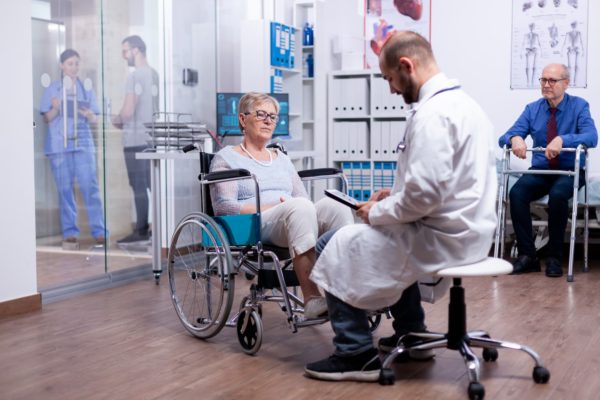What is Parkinson’s?
A neurological condition that causes impairments in movement; notably tremor, rigidity and slowing of actions. Sometimes shortened to PD, it is caused by the loss of specific neurons in the movement pathways within the brain. In addition to movement impairments, people are commonly affected by non-motor symptoms such as cognitive impairment, sleep disruption, and mood and anxiety issues, to name a few.
What is Parkinson’s Disease?

Parkinson’s disease is a condition of the brain that causes a resting tremor which is typically worse in one side compared to the other. It is a neurodegenerative disease for which there is no cure and typically increases in severity with time. Currently available medications which target dopaminergic pathways (a pathway in the brain where the predominant signalling molecule is dopamine) have been a success for Parkinson’s disease treatment. However, some patients are affected by treatment-resistant motor symptoms, treatment induced movement disorders, and non-motor symptoms for which there are limited therapeutic options.
Parkinson’s disease is most common in adult males over the age of 50 and globally the number of individuals with Parkinson’s disease is estimated to double between 2005 to 2030.
What Causes Parkinson’s Disease?
The exact cause of Parkinson’s is unknown but the disease is defined by a loss of dopaminergic (or dopamine containing) nerve cells in the substantia nigra part of the brain. The substantia nigra is a part of a group of structures called the basal ganglia, which play an essential role in the co-ordination of movement.
In addition, people with Parkinson’s disease also contain abnormal build-up of protein in structures called Lewy bodies.
Whilst it is more common in people over the age of 50, there are cases of people under 50 being diagnosed with Parkinson’s disease.
Is Parkinson’s Disease Hereditary?
Genetics can play a role in developing the disease, however direct genetic inheritance of Parkinson’s disease from a parent is rare.
Parkinson’s Disease Symptoms

Parkinson’s symptoms may start off mild and often begin with resting tremors of the hands. Typically symptoms are worse on one side compared to the other. Additional Parkinson’s disease symptoms may follow later including:
- Slowed movements
- Stiff muscles
- Posture and balance impairment, leading to falls
- Loss of autonomic nervous responses leading to urinary symptoms and drops in blood pressure going from sitting to standing
- A change in speech, often speech becomes slurred
- A change in or loss of ability to write
- Disorders of sleep
- Mood or anxiety disorders
- Fatigue
- Pain
- Visual hallucinations
- Dementia
Types of Parkinsonism
- Idiopathic Parkinson’s Disease: The most common type for which the cause is unknown. Symptoms are tremors, muscle rigidity, and slowness of movement.
- Vascular Parkinsonism: Affects those with restricted blood flow to the brain, sometimes people who have had a mild stroke develop this type of Parkinsonism. Symptoms include problems with memory, sleep, mood, and movement.
- Drug-induced Parkinsonism: Caused by prescription drugs taken to treat schizophrenia and other psychotic disorders. Drug-induced Parkinsonism is not a degenerative form of Parkinsonism and typically symptoms go away upon stopping the drug causing symptoms.
- Lewy Body Dementia: A type of dementia caused by the build-up of proteins in the brain that has some similar symptoms to Parkinson’s disease.
- Multiple System Atrophy (MSA): A rare condition that causes symptoms similar to those of Parkinson’s disease. The damage to parts of the nervous system controlling functions such as heart rate, blood pressure and perspiration is more common in sufferers of MSA.
- Progressive Supranuclear Palsy: As with MSA, symptoms of Progressive Supranuclear Palsy are similar to those of Parkinson’s disease, but additional features differentiate it from idiopathic Parkinson’s disease.
- Normal Pressure Hydrocephalus (NPH): Triggered by an abnormal build-up of cerebrospinal fluid in the brain’s ventricles or cavities, NPH is a cause of Parkinsonism.
How is Parkinson’s Disease Diagnosed?
Parkinson’s disease diagnosis is given based upon symptoms, medical history, and full physical examination carried out by a healthcare professional; there isn’t a test for the disease. It can be hard to diagnose at the onset as early signs of Parkinson’s disease are normally very mild.
For those with atypical features of Parkinson’s Plus syndromes MRI brain and functional neuroimaging may be performed.
Parkinson’s Disease Treatment

There is not a cure for Parkinson’s disease, but there are treatment options to reduce symptoms and slow progression. Parkinson’s treatments include:
- Physiotherapy to strengthen muscles, improve posture and support balance
- Prescription medications (L-DOPA, with additional modulatory therapies, being the gold standard for Parkinson’s disease and parkinsonism more broadly)
- Surgery where appropriate
Medical Cannabis for Parkinson’s Disease
Day-to-day life with Parkinson’s disease may be challenging, particularly in advanced stages. Medical cannabis may be appropriate for some patients as part of a wider treatment plan, to address related tremors, anxiety, pain and sleep quality.
If you’re considering this option, Curaleaf Clinic is here to guide you through the process. Learn more about our Curaleaf Access Scheme and explore whether it might be suitable for you.

